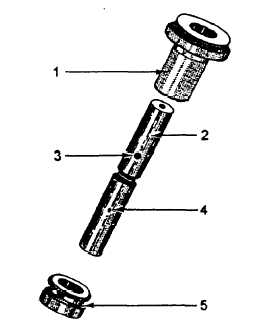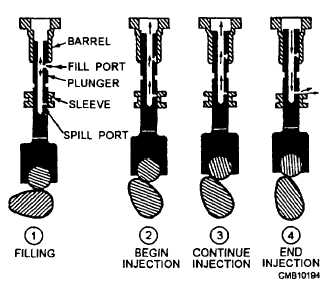1. To have fewer moving parts and fewer total parts.
2. Simple design with compactness.
3. It can use a simple mechanical governor. No hydraulic assist required.
4. The injection pump housing is filled with fuel oil, rather than crankcase oil for lubrication of all internal parts.
5. The plunger, barrel, and sleeve design used in all Caterpillar sleeve metering units follows a common style.
6. The transfer pump, governor, and injection pump are mounted in one unit.
7. Uses a centrifugal timing advance for better fuel economy and easier starts.
The term sleeve metering comes from the method used to meter the amount of fuel sent to the cylinders - a sleeve system (fig. 5-10). Rather than rotate the plungers to control the amount of fuel to be injected, like most pump and nozzle injection systems, the use of a sleeve is incorporated with the plunger. The sleeve blocks a spill port that is drilled into the plunger. The
1. Barrel
2. Plunger
3. Fill port
4. Spill port
5. Metering sleeve

Figure 5-10. - Sleeve metering barrel and plunger assembly.
amount of plunger travel with its port blocked determines the amount of fuel to be injected. Basic operation is as follows:
Fuel is drawn from the fuel tank by the transfer pump through the fuel/water separator and the primary and secondary filters.
Fuel from the transfer pump fills the injection pump housing at approximately 30 to 35 psi with the engine operating under full load. Any pressure in excess of this will be directed back to the inlet side of the transfer pump by the bypass valve. A constant-bleed valve is also used to allow a continuous return of fuel back to the tank at a rate of approximately 9 gallons per hour, so the temperature of the fuel stays cool for lubrication purposes and assist in maintaining housing pressure.
Since the injection pump is constantly filled with diesel from the transfer pump under pressure, any time the fill port is uncovered, the internal drilling of the plunger will be primed by the incoming fuel caused by the downward moving plunger relative to pump camshaft rotation (fig. 5-11).
At the correct moment, the rotation of the pump cam lobe begins to force the plunger upward until the fill port is closed, as it passes into the barrel. At the same time the sleeve closes the spill port. The pump, line, and fuel valves are subjected to a buildup in fuel pressure and injection will begin (fig. 5-11).

Figure 5-11. - Injection pump operating cycle.
Continue Reading